Blade CP & CP Pro - popular helicopters by E-flite
|
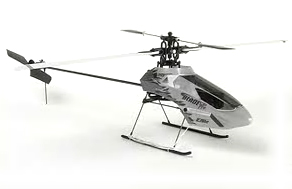 |
I once wrote to notorious helifreak Philosophicle_1, "...the Blade is a troll that lives under a bridge that we all must cross." Many accomplished RC heli pilots have a Blade (along with a Trex 450) that they fly whenever they want to. The near-universal acceptance of this micro heli convinced me that any reasonably accomplished RC heli pilot should be able fly it. At first I could not get the Blade off the ground long enough to hover it. Then I could hover but nothing more. As I progressed through side-in hovering and forward flight became possible I found more to like about my Blade CP Pro.
Lightweight simplicity - at 11 ounces it flies well with the stock, brushed motor and balsa main rotor blades. When you learn how to take off and land it softly the light, slender carbon fiber (CF) landing gear works fine. Beginners make much of putting 'Super Skidz' on their Blades but the heavier landing gear impairs balance and handling. The more parts you hang on your Blade the more it will slide backwards towards you when you hover it. And the heavier it becomes the more impact energy there will be during a crash.
If you have not flown RC before the Blade CP or Blade CP Pro will be frustrating at first. These helicopters require more perseverance than a lot of RC pilots thought would be necessary. The fabled 'Lightning-fast collective response' that E-flite brags about in its advertising is an accurate description of how it handles. Since the helicopter promptly does what you tell it to beginners' control errors can rapidly result in crashes, which is why beginners often fly the Blade with sweaty palms! As you start to get it you will take off and hover with increasing confidence. Of course you will want to do more than that. In the process of turning it side-in you will eventually find yourself pulling off some spectacular 'saves'—the first indication that responsivness can be a good thing. When you begin to establish control the Blade's stunning maneuverability lets you instantly change the heli's direction and angle of flight. It flies like a little hot rod.
Ease of repairs - the Blade is so simple that most repairs only take a half-hour when you are familiar with changing the main gear and shaft (a common repair), spindle shaft, landing gear, and of course, main blades.
Useful Mods - people put all kinds of after-market parts on their Blades. I see it as a simple, lightweight flyer that works well few modifications:
- Telebee heading hold (HH) gyro
- Better tail motor
- Heat sinks on main and tail motors (if a single tail motor is used)
- Balsa main blades
- Rotor head affixed to main shaft with soft paper clip wire
You can fly the Blade okay with the gyro on the 4-in-1. A heading hold gyro (HH) makes the tail steadier. Telebee 6 and 11 gram gyros are light and work well. The tail motor simply must be upgraded once you get past the hovering stage. There are three ways to go: a direct drive motor and propellor, tandem motors; a brushless motor. Direct drive increases power, adds some weight, and burns out sooner than you like. Using two tail motors adds weight, extends motor life, increases power. The brushless motor gives power, adds some weight (not too much), and requires soldering. It works best with a computer radio capable of programmable mixing to get the brushless tail motor to play nice with the rest of the helicopter's systems.
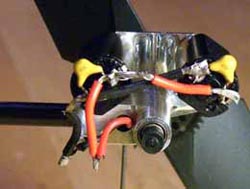 |
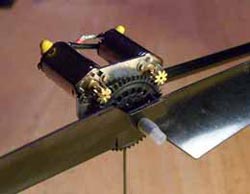 |
|
Two tail motors on a Flight Tech mount. By sharing the load the motors run cool. |
||
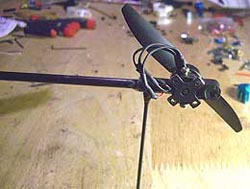 |
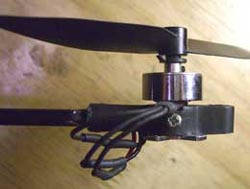 |
|
Brushless tail motor in a modified stock tail motor mount. The best power and control. |
||
You can spend a lot of money on main blades from E-flite or buy wood blades by E-sky (for Honey Bee CP/2 heli's) on-line for less than half. Wood blades break in a severe crash, which reduces stress on neighboring parts. Plastic or carbon fiber (CF) blades don't break so their rotational energy (which must go somewhere) is transfered to the rotor head—breaking parts and bending the main and spindle shafts. Likewise if you use a piece of paperclip wire instead of E-flite's steel retainer pin to fix the rotor head on the main shaft the clip will shear during a crash. When the pin shears less energy is transferred from the rotating main blades to the main shaft and rotor head. The result is fewer broken parts. If you are lucky the main shaft will not bend—or not bend so much that it is unusable.
One more tip: after trying it both ways as a beginner I recommend using symmetrical blades instead of flat-bottomed blades. Flatties don't help you get down when a gust of wind lifts the heli higher than you want it to go. You will eventually use symmetrical blades anyway for superior control; you may as well start out with them. The lowest pitch setting (pitch curve point 1 on the transmitter) should give you two degrees of negative pitch so you can bring the heli down if wind lifts it too fast or too high.
When you reach the stage where you rarely crash and are comfortable flying in wind you can boost performance considerably with a brushless motor (BM). When I (finally) got comfortable flying in wind I installed the Park 370 brushless motor and electronic speed controller (ESC) sold by E-flite and it made a remarkable difference in performance. (Paper clip wire can't be used to sescure the head to the main shaft with this motor.) But there is little point for a new RC pilot to go out and buy every mod available for the Blade. Just get it to hover reliably and start working your way towards side-in hovering and forward flight.
Blade CP Pro indoors, dual tail motors |